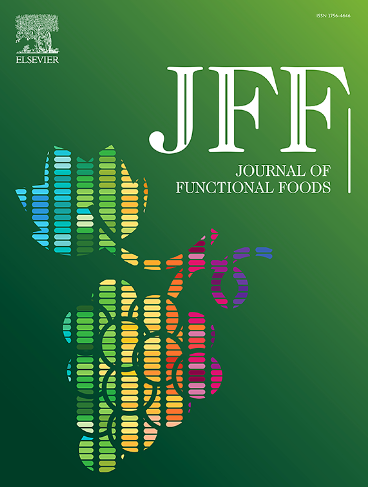Antioxidant peptides (FYDQ and FVEG) derived from cricket (Acheta domesticus) protein hydrolysate enhance photoprotection and inhibit apoptosis in UVB-irradiated HaCaT keratinocytes cells
IF 3.8
2区 农林科学
Q2 FOOD SCIENCE & TECHNOLOGY
引用次数: 0
Abstract
Antioxidant peptides are extensively used in food, pharmaceuticals, and cosmetics. Two tetrapeptides, Phe-Tyr-Asp-Gln (FYDQ) and Phe-Val-Glu-Gly (FVEG), were previously identified from cricket (Acheta domesticus) protein hydrolysate. Molecular docking of these tetrapeptides showed high binding affinity to antioxidant-related proteins: Keap1, Superoxide dismutase (SOD), Catalase (CAT), GR (Glutathione reductase), and Glutathione peroxidase (GPx). In this study, FYDQ and FVEG were selected and evaluated for their protective effect against oxidative damage induced by UVB irradiation of human keratinocytes cells (HaCaT). Pretreatment with 100 μg/mL of each tetrapeptide before UVB irradiation resulted in intracellular photoprotective activity by reducing reactive oxygen species (ROS). These were accumulated by approximately two-fold compared to the UVB-irradiated HaCaT cells and restored the activity of antioxidant enzymes. Additionally, pretreatment with the tetrapeptides prior to UVB irradiation inhibited cellular apoptosis by approximately 30 % compared to the UVB-irradiated group. This was achieved by reducing the loss of mitochondrial membrane potential (MMP) by about 40 % and repressing the expression of cleaved caspase-3 and BAX by about two-fold compared to the UVB-irradiated group. FVDQ and FVEG demonstrate protective effects against UVB-induced oxidative damage through ROS scavenging leading to attenuated cellular apoptosis. Both tetrapeptides might be utilized as antioxidant components in sunscreen formulations or anti-photoaging cosmetic products.

从蟋蟀(Acheta domesticus)蛋白水解物中提取的抗氧化肽(FYDQ和FVEG)增强了uvb照射下HaCaT角质形成细胞的光保护作用并抑制了细胞凋亡
抗氧化肽广泛应用于食品、医药、化妆品等领域。先前从蟋蟀(Acheta domesticus)蛋白水解物中鉴定出两个四肽,即ph - tyr - asp - gln (FYDQ)和ph - val - glu - gly (FVEG)。这些四肽的分子对接显示出与抗氧化相关蛋白Keap1、超氧化物歧化酶(SOD)、过氧化氢酶(CAT)、谷胱甘肽还原酶(GR)和谷胱甘肽过氧化物酶(GPx)的高结合亲和力。本研究选择FYDQ和FVEG对UVB照射下人角质形成细胞(HaCaT)氧化损伤的保护作用进行了评价。UVB照射前预处理各四肽100 μg/mL,可通过减少活性氧(ROS)产生细胞内光保护活性。与uvb照射的HaCaT细胞相比,这些物质的积累量约为两倍,并恢复了抗氧化酶的活性。此外,与UVB照射组相比,在UVB照射前用四肽预处理可抑制约30%的细胞凋亡。这是通过将线粒体膜电位(MMP)的损失减少约40%,并将cleaved caspase-3和BAX的表达抑制约为uvb照射组的两倍来实现的。FVDQ和FVEG对uvb诱导的氧化损伤具有保护作用,通过清除ROS导致细胞凋亡减弱。这两种四肽都可以作为抗氧化成分用于防晒配方或抗光老化化妆品中。
本文章由计算机程序翻译,如有差异,请以英文原文为准。
求助全文
约1分钟内获得全文
求助全文
来源期刊

Journal of Functional Foods
FOOD SCIENCE & TECHNOLOGY-
CiteScore
9.60
自引率
1.80%
发文量
428
审稿时长
76 days
期刊介绍:
Journal of Functional Foods continues with the same aims and scope, editorial team, submission system and rigorous peer review. We give authors the possibility to publish their top-quality papers in a well-established leading journal in the food and nutrition fields. The Journal will keep its rigorous criteria to screen high impact research addressing relevant scientific topics and performed by sound methodologies.
The Journal of Functional Foods aims to bring together the results of fundamental and applied research into healthy foods and biologically active food ingredients.
The Journal is centered in the specific area at the boundaries among food technology, nutrition and health welcoming papers having a good interdisciplinary approach. The Journal will cover the fields of plant bioactives; dietary fibre, probiotics; functional lipids; bioactive peptides; vitamins, minerals and botanicals and other dietary supplements. Nutritional and technological aspects related to the development of functional foods and beverages are of core interest to the journal. Experimental works dealing with food digestion, bioavailability of food bioactives and on the mechanisms by which foods and their components are able to modulate physiological parameters connected with disease prevention are of particular interest as well as those dealing with personalized nutrition and nutritional needs in pathological subjects.
 求助内容:
求助内容: 应助结果提醒方式:
应助结果提醒方式:


